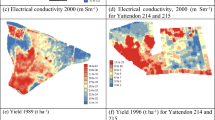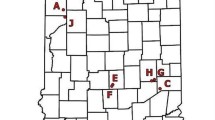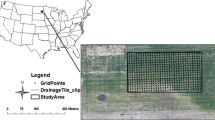Abstract
A four-year study was conducted from 2000 to 2004 at eight field sites in Montana, North Dakota and western Minnesota. Five of these sites were in North Dakota, two were in Montana and one was in Minnesota. The sites were diverse in their cropping systems. The objectives of the study were to (1) evaluate data from aerial photographs, satellite images, topographic maps, soil electrical conductivity (ECa) sensors and several years of yield to delineate field zones to represent residual soil nitrate and (2) determine whether the use of data from several such sources or from a single source is better to delineate nitrogen management zones by a weighted method of classification. Despite differences in climate and cropping, there were similarities in the effectiveness of delineation tools for developing meaningful residual soil nitrate zones. Topographic information was usually weighted the most because it produced zones that were more correlated to actual soil residual nitrate than any other source of data at all locations. The soil ECa sensor created better correlated zones at Minot, Williston and Oakes than at most eastern sites. Yield data for an individual year were sometimes useful, but a yield frequency map that combined several years of standardized yield data was more useful. Satellite imagery was better than aerial photographs at most locations. Topography, satellite imagery, yield frequency maps and soil ECa are useful data for delineating nutrient management zones across the region. Use of two or more sources of data resulted in zones with a stronger correlation with soil nitrate.



Similar content being viewed by others
References
Becki, H. J., Moulin, A. P., & Pennock, D. J. (1997). Strategies for variable rate N fertilization in hummocky terrain. Canadian Journal of Soil Science, 77, 589–595.
Bhatti, A. U., Mulla, D. J., & Frazier, B. E. (1991). Estimation of soil properties and wheat yields on complex eroded hills using geostatistics and thematic mapping images. Remote Sensing of Environment, 37, 181–191.
Blackmore, S. (2000). The interpretation of trends from multiple yield maps. Computers and Electronics in Agriculture, 26, 37–51.
Cassel, D. K., Kamprath, E. J., & Simmons, F. W. (1996). Nitrogen-sulfur relationships in corn as affected by landscape attributes. Agronomy Journal, 88, 133–140.
Franzen, D. W. (2004). Delineating nitrogen management zones in a sugarbeet rotation using remote sensing—A review. Journal of Sugarbeet Research, 41, 47–60.
Franzen, D. W. (2008). Yield mapping. SF-1176–3. Fargo, ND: North Dakota State University Extension.
Franzen, D. W., Cihacek, L. J., Hofman, V. L., & Swenson, L. J. (1998). Topography-based sampling compared with grid sampling in the Northern Great Plains. Journal of Production Agriculture, 11, 364–370.
Franzen, D. W., Hofman, V. L., Cihacek, L. J., & Swenson, L. J. (1999). Soil nutrient relationships with topography as influenced by crop. Precision Agriculture, 1, 167–183.
Franzen, D. W., Landgraff, A. J., Giles, J. F., Cattanach, N. R., & Reitmeier, L. J. (2000). Nitrogen availability and movement within wheat fields following sugarbeets. In 1999 Sugarbeet Research and Extension Reports. (Vol. 30. pp. 117–126). Fargo, ND: Sugarbeet Research and Education Board of Minnesota and North Dakota.
Fulton, J. P., Shearer, S. A., Chabra, G., & Higgins, S. F. (1999). Performance assessment and model development of a variable-rate, spinner-disc fertilizer applicator. Transactions of the ASAE, 44, 1071–1081.
Heiniger, R. W., McBride, R. G., & Clay, D. E. (2003). Using soil electrical conductivity to improve nutrient management. Agronomy Journal, 95, 508–519.
Hornung, A., Khosla, R., Reich, R., Inman, D., & Westfall, D. G. (2006). Comparison of site-specific management zones: Soil-color-based and yield-based. Agronomy Journal, 98, 407–415.
Karlen, D. L., Cambardella, C. A., & Colvin, T. S. (1996). Soil-test variability in adjacent Iowa fields. In P. Robert (Ed.), Precision agriculture: Proceedings of the 3rd international conference, 23–26 June, 1996. Minneapolis, MN (pp. 237–243). Madison, WI: ASA-CSSA-SSSA.
Kravchenko, N. A., & Bullock, D. G. (2000). Correlation of corn and soybean grain yield with topography and soil properties. Agronomy Journal, 92, 75–83.
Long, D. S., & Pierce, F. J.(2010). Precision farming for nitrogen management. In J. A. Delgado & R. F. Follett (Eds.) Advances in nitrogen management for water quality. Ankeny, IA: Soil and Water Conservation Service (in press).
Mulla, D. J., & Bhatti, A. U. (1997). An evaluation of indicator properties affecting spatial patterns in nitrogen and phosphorus requirements of winter wheat yield. In J. V. Stafford (Ed.), Precision agriculture ‘97 (pp. 145–153). Oxford, UK: BIOS Scientific Publishers.
Pennock, D., Walley, F., Solohub, M., Si, B., & Huatowich, G. (2001). Topographically controlled yield response of canola to N fertilizer. Soil Science Society of America Journal, 65, 1838–1845.
Pierce, F. J., & Nowak, P. (1999). Aspects of precision agriculture. In D. L. Sparkes (Ed.), Advances in agronomy (Vol. 67, pp. 1–85). San Diego, CA: Academic Press.
Shaner, D. L., Khosla, R., Brodahl, M. K., Buchleiter, B. W., & Farahani, J. (2008). How well does zone soil sampling based on soil EC maps represent soil variability. Agronomy Journal, 100, 1472–1480.
Song, X., Wang, J., Huang, W., Liu, L., Yan, G., & Pu, R. (2009). The delineation of agricultural management zones with high resolution remotely sensed data. Precision Agriculture, 10, 471–487.
Stevenson, F. C., & van Kessel, C. (1996). A landscape-scale assessment of the nitrogen and non-nitrogen benefits of pea in a crop rotation. In P. Robert (Ed.), Precision agriculture: Proceedings of the 3rd international conference , 23–26 June, 1996, Minneapolis, MN (pp. 55–64). Madison, WI: ASA-CSSA-SSSA.
Sudduth, K. A., Kitchen, N. R., Bollero, G. A., Bullock, D. G., & Wiebold, W. J. (2003). Comparison of electromagnetic induction and direct sensing of soil electrical conductivity. Agronomy Journal, 95, 472–482.
Tabor, J. A., Warrick, A. W., Myers, D. E., & Pennington, D. A. (1985). Spatial variability of nitrate in irrigated cotton II: Soil nitrate and correlated variables. Soil Science Society of American Journal, 49, 390–394.
Taylor, R. K., Kluitenberg, G. J., Schrock, M. D., Zhang, N., Schmidt, J. P., & Havlin, J. L. (2001). Using yield monitor data to determine spatial crop production potential. Transactions of the ASAE, 44, 1409–1414.
White, R. E., Haigh, R. A., & Macduff, J. H. (1987). Frequency distributions and spatially dependent variability of ammonium and nitrate concentrations in soil under grazed and ungrazed grassland. Fertilizer Research, 11, 193–208.
Acknowledgment
The authors express appreciation to the USDA-CSREES-IFAFS award #00-52103-9652, for funding this project.
Author information
Authors and Affiliations
Corresponding author
Rights and permissions
About this article
Cite this article
Franzen, D., Long, D., Sims, A. et al. Evaluation of methods to determine residual soil nitrate zones across the northern Great Plains of the USA. Precision Agric 12, 594–606 (2011). https://doi.org/10.1007/s11119-010-9207-0
Published:
Issue Date:
DOI: https://doi.org/10.1007/s11119-010-9207-0




